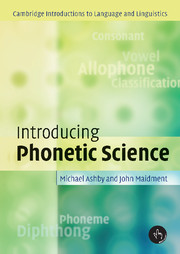4 - Manner of articulation
Published online by Cambridge University Press: 05 June 2012
Summary
CHAPTER OUTLINE
In this chapter you will learn: how the articulators may constrict the airstream in different ways for the production of consonant sounds; how sounds may be classified according to manner of articulation; how sounds may be classed as obstruent or sonorant; how manners of articulation are used in the world's languages.
KEY TERMS
Affricate
Approximant
Degree of stricture
Flap
Fricative
Lateral
Manner of articulation
Median
Nasal
Obstruent
Plosive
Sonorant
Stop
Tap
Trill
Introduction
We have now seen that consonant sounds may differ in voicing and in place of articulation. The final basic distinction between consonants is known as manner of articulation and that is the subject of this chapter. A manner of articulation label, such as ‘plosive’ or ‘fricative’, refers to the way in which the airstream used for a speech sound is modified by the primary and secondary articulators. Is the airstream completely blocked? Can the air escape through the nasal cavity? Does the air pressure inside the vocal tract rise? These are the sorts of questions we will be investigating below.
Once we have learnt to apply manner labels correctly we shall be in a position to give a three-term label to a consonant, specifying its Voice, Place, Manner, usually abbreviated VPM. VPM labels are useful shorthand for identifying most consonants of the world's languages, although they are not the complete story by any means.
- Type
- Chapter
- Information
- Introducing Phonetic Science , pp. 51 - 68Publisher: Cambridge University PressPrint publication year: 2005



